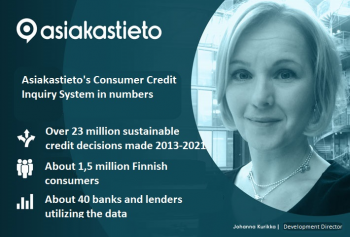Positive credit information in consumer credit inquiry system
Did you know that positive credit report information is already available?
“We use the positive credit information service of Asiakastieto in all of our application channels and it is an important part of our credit decision process. It would be difficult to give up using this service since, through it, we can verify information about customers’ financial situations in real time,” says Jermu Säippä.
What is meant by positive credit information?
In Finland, negative credit information is payment default data available in a credit information register. Positive credit information again is other information describing a person’s ability or willingness to attend to their payment obligations. This information has been collected typically from the credit applicant; for example, by requesting a salary receipt or information about other loans. The information may have a positive or negative impact on the person’s ability to pay their loans.
For which purpose can positive credit information be used?
The information can only be used with the person’s consent for the assessment of payment ability, when credit granting is considered. The companies in the service have signed contracts specifying the use of information in detail.
Why is positive information conveyed?
The information is conveyed so that companies can avoid credit losses and that new loans do not make the consumer fall into payment difficulties. It is beneficial both for the consumer and company that a loan is raised only in the amount that is possible to pay back. Positive credit information reduces the possibility of overindebtedness already before payment defaults are generated.
How does the system differ from a so-called positive credit information register?
As its name suggests, the positive credit information register is a centralised register, to which credit grantors update their data, for example, each month. Such a register is used, among others, in Sweden and in most countries in Europe. In the system maintained by Asiakastieto, positive credit information is collected real-time on a case by case basis from the credit grantors’ customer files by order of the consumer. The information is not recorded into a credit information register, and a new register is not founded in the system.
Can a credit applicant prevent the use of their own positive information when applying for credit?
A credit applicant is always asked consent for the search of positive credit information. Credit can be applied without giving a consent. Giving the consent is always voluntary. If information on a consumer has been conveyed in the system in connection with a credit application, they have the right to inspect their information.
Is the system safe?
The functionality of the system is based on the trust of both consumers and credit grantors. The same strict requirements concern the use of information in the system as other types of credit information. The protection of privacy is vital in Asiakastieto’s principles of operation.
Which type of credits is the system used for and who use it?
The system has been established for the granting of consumer credits. Participants in the system are companies granting consumer credits. Part of the participants convey more limited data content (more limited data and the companies conveying these are marked with *)

- Positive credit information describes a person’s ability or willingness to attend to their payment obligations.
- The information can only be used with the person’s consent for the assessment of payment ability, when credit granting is considered.
- Positive credit information reduces the possibility of overindebtedness already before payment defaults are generated.
Danske Bank is utilizing Asiakastieto's Positive Credit data
Danske Bank is utilizing Asiakastieto's Positive Credit data
Danske Bank is a sustainable lender. They utilize Asiakastieto's Positive Credit data for decision making in all their application channels. "It is an essential part of our credit granting process", Jermu Säippä from Danske Bank says.
The companies participating in the exchange of information in the system
|
|
The positive information to be conveyed is:
|
|


